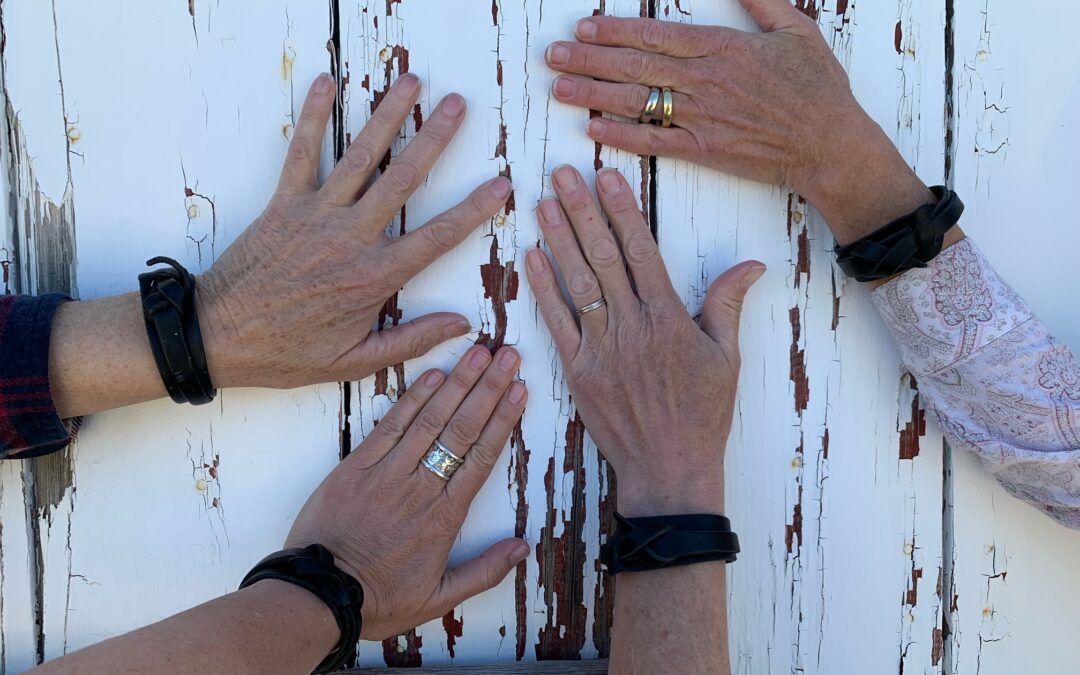Listen to the full podcast episode here or wherever you stream your podcasts!
Our first unofficial Dinner with Artists came together in Quang Ho’s apartment on the first warm day of the year. A room full of, mostly, women artists for the ultimate dinner party to discuss a connection they made in their art through a most unexpected way. Just outside the breathtaking Great Sand Dunes National Park, nestled in the San Luis Valley, lies Zapata Ranch—a sprawling 50,000-acre land graced by a majestic bison herd and an enchanting Lodge that serves as a haven for guests, retreats, and, most importantly, artists.
Back in 2007, Jill Soukup discovered Zapata and immediately sensed the artistic energy and transformative potential within its embrace. She wasted no time in reaching out to her fellow friends and artists Stephanie Hartshorn, Amy Laugesen, and Sophy Brown, practically demanding, “You have to go see this old homestead!”
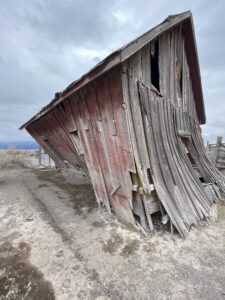
Homestead on Zapata Ranch
As we shared a potluck meal of Sophy’s upside down quiche pie, Stephanie’s summertime salad, and Amy’s fig newtons (I’ll mention this later), we were transported back to the humble beginnings of their collaborative efforts, where each artist found solace in pooling her skills and resources. Little did they know that their collaboration would evolve into a profound creative force, igniting innovation, bridging diverse perspectives, and shaping the very essence of their artistic expression.
It is worth mentioning that collaboration is a double-edged sword, it can also sow seeds of animosity and competition between artists. So, what exactly brought these remarkable women together in the first place?
Pieces of the puzzle
As if it was gently tapping them on the shoulder, these women were inspired by the land, the presence of bison, and an abandoned structure brimming with history. Their journey would see them venturing into the vast expanse of the land, only to reconvene hours later, each holding a piece of metal or wood that had captured their imagination.
Lo and behold, they began combining their discoveries with each other’s wires and glass, weaving a tapestry of creativity and collaboration. Together, these four talented souls brought forth the vital elements that would fuel their impromptu artistic alliance.
Stephanie, the vivacious spirit among them, dubbed herself the “stick gatherer” of the group. With a knack for puzzle-solving, she always found a way to piece things together. Meanwhile, Jill and Amy embodied the quieter voices, but don’t let that fool you. Amy’s resourcefulness with materials and her newfound passion for the San Luis Valley, having recently relocated there, added a unique touch to their collaboration. And let’s not forget Jill, whose immense sense of harmony became the driving force that guided the team forward.
Now, if there’s one thing they all agreed upon unanimously, it was that Sophy, the proclaimed ringleader, possessed an endless wellspring of ideas, coupled with an unwavering commitment to the collective. Each woman stepped into the role of a studio assistant, shifting their focus from “me” to “us,” finding innovative ways to support one another.
Past to Present
In her recent Artnet article, Sarah Cascone gave us a glimpse into the reattribution of Artemisia Gentileschi’s masterpiece, “Abraham and the Three Angels.” Once attributed solely to Bernardo Cavallino, it is now recognized as a collaboration between Gentileschi and her studio assistant, Onofrio Palumbo, who contributed one of the angels and a portion of the background. This revelation sheds light on the practice of collaboration among the Old Masters, where studio assistants played a pivotal role, offering their input, perspective, and even labor in the creation process.
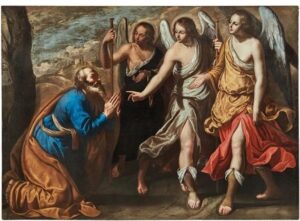
Abraham and the Three Angels, Artemisia Gentileschi and Onofrio Palumbo
In a captivating episode of the podcast “Art Curious,” host Jennifer Dassel uncovers the dynamic relationship between Jacob Lawrence and his wife, Gwendolyn Knight during the Harlem Renaissance. After years of working together, Lawrence celebrated the couple’s collaborative synergy, emphasizing the immeasurable value of having a respected partner by his side.
These partnerships not only showcase the power of trust and respect but also exemplifies the incredible value of contributing these qualities, which we can witness among the four inspiring women of Zapata Ranch.
Against Time
Aware that their time on the land was uncertain due to management transitions, the idea to create a bison sculpture using found objects began to take shape. Even without formal tools for assembly, the significance of each woman’s role in the project cannot be understated.
Pieces of wood were meticulously positioned without soldering, defying gravity and creating a harmonious composition. As fate would have it, one artist stumbled upon a metal piece resembling a buffalo’s ears, while another discovered a buffalo ear tag. After nearly six hours of seamless collaboration, a magnificent buffalo sculpture emerged.
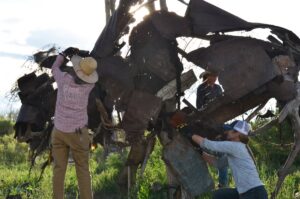
The four women bringing the buffalo sculpture to life
The collective experience left a profound impact on each artist, propelling them to dive deeper into their individual artistic practices. This newfound sense of liberation nurtured an environment that allowed them to express their voices in ways that clients and galleries may have limited. Zapata Ranch became their Yellow House, their Bauhaus—a transformative space that ignited their artistic spirits, much like Van Gogh and Gauguin’s legendary collaboration.
Jill, in particular, shared how this collaborative endeavor enabled her to breathe life into three paintings she had been dreaming of creating for nearly a decade. But their creative synergy didn’t stop there. Together, they embarked on numerous projects around the property, exploring diverse mediums and ideas that surprised and delighted each of them.
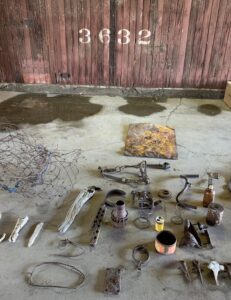
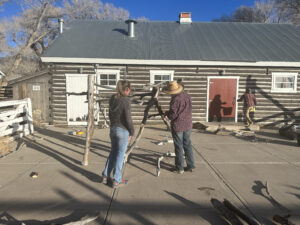
From crafting captivating flat lays to capturing mesmerizing timelapse videos, there seemed to be no limit to the creativity that these women brought out in one another. Sophy’s voice, brimming with excitement, as she pondered aloud about future projects they could embark on—perhaps a glass mosaic using the moonshiner’s bottles they stumbled upon, their colors transformed over time by the minerals of the earth.
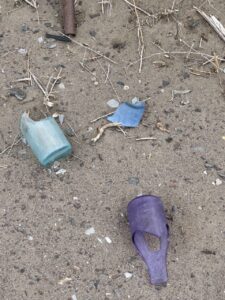
Embracing collaboration
Bound by the goodwill of nature, the pull of the past, and a shared respect for the spirit of Zapata Ranch, these remarkable women transformed dreams into tangible realities, defying the limits of artistic possibility.
As we sat around the kitchen island sharing stories, the influence of the past and each other became very clear. Each artist shared the inspiration of their dish, most from a family or comfort recipe. Amy explains that even though her fig newtons were store bought, her many times removed great grandfather owned and operated the original factory where the first fig newtons were produced. She continued to bring the past forward, even into this random apartment in Denver, Colorado.
Through their unyielding dedication and artistic synergy, Jill, Stephanie, Amy, and Sophy have not only created captivating found art artwork but have also forged connections that transcend the boundaries of their individual talents. The four women of Zapata Ranch have unveiled a world where dreams materialize, where the impossible becomes possible, and where the power of collaboration transcends the limitations of individual artistry.
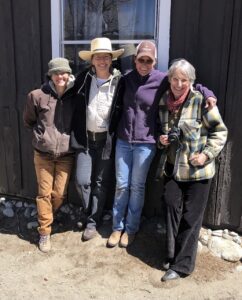
(left to right) Amy, Stephanie, Jill, and Sophy on Zapata Ranch
Listen to the full podcast episode here or wherever you stream your podcasts!

